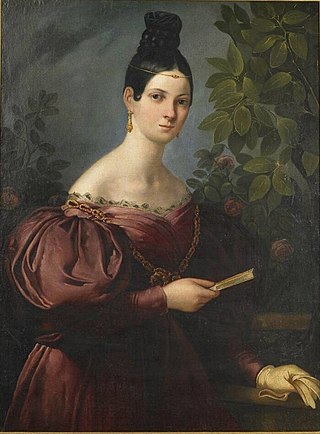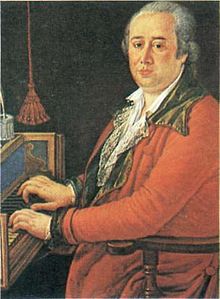
Maria Anna MarziaAlboni was an Italian contralto opera singer. She is considered "one of the greatest contraltos in operatic history".

Domenico Cimarosa was an Italian composer of the Neapolitan School and of the Classical period. He wrote more than eighty operas, the best known of which is Il matrimonio segreto (1792); most of his operas are comedies. He also wrote instrumental works and church music.

The Clandestine Marriage is a comedy by George Colman the Elder and David Garrick, first performed in 1766 at Drury Lane. It is both a comedy of manners and a comedy of errors. The idea came from a series of pictures by William Hogarth entitled Marriage à-la-mode.

Maria Felicia Malibran was a Spanish singer who commonly sang both contralto and soprano parts, and was one of the best-known opera singers of the 19th century. Malibran was known for her stormy personality and dramatic intensity, becoming a legendary figure after her death in Manchester, England, at age 28. Contemporary accounts of her voice describe its range, power and flexibility as extraordinary.

Luis Ernesto Alva y Talledo, better known as Luigi Alva is a Peruvian operatic tenor. A Mozart and Rossini specialist, Alva achieved fame with roles such as Don Ottavio, Count Almaviva and Fenton. He retired from the stage in 1989.
Graziella Sciutti was an Italian soprano opera singer and later vocal teacher and opera producer.

Natalie Bodanya was an American operatic soprano who had an active international career from the late 1920s through the 1940s. She notably sang at the Metropolitan Opera in New York City from 1937 through 1942 and was a performer with the New York City Opera during the company's 1943-1944 inaugural season.

Margherita Rinaldi was an Italian lyric soprano, primarily active in the 1960s and 1970s, after she made her debut as Donizetti's Lucia di Lammermoor in 1958, prompting her career at La Scala in Milan. She also appeared internationally, performing a wide repertoire including, besides Italian belcanto roles, Baroque and French opera. She recorded the roles of Gilda in Verdi's Rigoletto and Ilia in Mozart's Idomeneo. From 1981, she worked as a voice teacher.

Sesto Bruscantini was an Italian baritone, one of the greatest buffo singers of the post-war era, especially renowned in Mozart and Rossini.
Eugenia Ratti was an Italian soprano, particularly associated with the Italian repertory. A lyric coloratura soprano of considerable charm, she excelled in soubrette roles in works by Cimarosa and Mozart such as Susanna, Zerlina, Despina, and in light Donizetti such as Adina, Norina, as well as Verdi's Oscar and Nannetta.
Manno Wolf-Ferrari was an Italian conductor, nephew of composer Ermanno Wolf-Ferrari.
Nino Sanzogno was an Italian conductor and composer.

Ines Maria Ferraris was an Italian operatic soprano and pianist who sang for more than two decades at La Scala in addition to appearances on the international stage. Although popular in Italy, she had a particularly devoted fanbase throughout South America. A light lyric soprano with a pure and agile voice, Ferraris sang a wide repertoire that encompassed the verismo operas of Puccini, the Italian grand opera of Verdi, and the German operas of Richard Strauss. She is particularly remembered for portraying the role of Lisette in the world première of Puccini's La rondine in 1917.
Karl Scully is an Irish opera tenor.

Mary Shaw was an English classical contralto who had an active international career in concerts and operas during the 1830s and 1840s. She is best remembered today for creating the role of Cuniza in the world premiere of Giuseppe Verdi's first opera Oberto at La Scala in 1839.
Marietta Sacchi was an Italian operatic soprano who had an active career during the 1820s and 1830s.

Sara Mingardo is an Italian classical contralto who has had an active international career in concerts and operas since the 1980s. Her complete recording of Anna in Hector Berlioz's Les Troyens won a Gramophone Award and both the Grammy Award for Best Opera Recording and the Grammy Award for Best Classical Album in 2002. Some of the other roles she has performed on stage or on disc include Andronico in Tamerlano, Mistress Quickly in Falstaff, Rosina in The Barber of Seville, and the title roles in Carmen, Giulio Cesare, Riccardo Primo, and Rinaldo. She has also recorded several Vivaldi cantatas, Bach cantatas, and such concert works as Mozart's Requiem, Rossini's Stabat Mater, and Vivaldi's Gloria among others.

Francesco Benucci was an Italian bass/baritone singer of the 18th century. He sang a number of important roles in the operas of Wolfgang Amadeus Mozart, Antonio Salieri and other composers.

Carolina Crespi, later known as Carolina Crespi-Bianchi and Carolina Bianchi, was an Italian soprano active on the opera stages of Paris and Northern Italy from 1803 to 1820. She was born in Prague, the daughter of the soprano Luigia Prosperi-Crespi (1770–1824). Crespi was married to the tenor Eliodoro Bianchi and appeared with him in three world premieres at La Scala.
Marie Perbost is a French operatic soprano.














